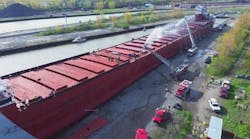Early decorations took many forms, since the old goose-neck hand pumpers were readily adaptable to fancy decoration by their very design. The high-backed panels left plenty of room for decoration. In fact, some of the best American artists at work in the early 19th century were commissioned by fire companies to paint panels and to design other decorations for their fire engines and hose carriages.
Plating of silver and gold was used to decorate the brass work. Gold leaf was used to place banners and streamers around artwork, then adapted to lettering on the rigs. Eventually, the use of gold leaf became synonymous with fire engine decoration. The addition of gold insignias and outlines, often quite elaborate, became commonplace on fire trucks.
An article in the November 1995 issue of Firehouse® reported on a new style of decorating rigs using modern technology but the most popular method is still traditional gold leafing. As Long Island, NY-based gold leaf artist Mike Norris explained, traditional gold leafing is far from dead. "As a matter of fact," he said, "I'm just as busy today as I was 20 years ago."
The gold leaf artist today not only decorates apparatus but continues a tradition that dates to the early days of American firefighting. Using techniques and tools that have evolved during thousands of years, since early Egyptian and Greek gilding, the modern gold leafer places scroll, letter and banner styles that also have a rich tradition themselves.
Some fire companies and departments have used the same styles of designs on their rigs from one new truck to the next. Lettering, scrollwork, styles of shading and banners that were made popular by manufacturers such as American LaFrance, Mack and Seagrave have carried on even if the fire companies have changed manufacturers for their new trucks.
The gold leafer painstakingly measures and adapts these classic old designs, then recreates them on fire trucks that in many cases have very different lines and styles to them. This is where the artist decides how best to work the gold leaf into classic designs on modern machines.
The designs are transferred to a "pounce pattern" (paper sheet) that is perforated along the design's lines. Chalk is pounced through the small holes to leave a soft outline of the desired artwork. A layout stabilo pencil is also used to outline the work.
"About half of the patterns we use are from older rigs," Norris explained as he examined the tape he had placed as a guide for striping. When the area to be leafed is laid out, a glue-like substance called "size" is applied and left to dry until it becomes tacky. Judging correct tackiness is the secret of good gold leafing.
The 23-carat gold is then applied, either from three-inch-by-three-inch sheets or from rolls used for stripes. The gold is about as thin as a human hair. One ounce of gold pounds out to about 100 square feet of gold leaf. At this point, wads of cotton are used to burnish the gold to the glue beneath it. This leaves the gold with a bright, shiny appearance. If the leafer wants to add depth, burlling is done to the gold by using a velvet pad and either hand turning or using a hand-held drill to add a swirling effect to the gold surface.
The artist continues by adding shading and shadows behind the lettering or artwork. Stripes and letters are edged with color to bring them out. The entire design area is then covered with a clear protective coating. Until the past decade, varnish was a popular covering due to its hard finish but this proved to be a problem, especially when subjected to temperature changes. The same modern technology that seemingly was making traditional gold leafing obsolete is actually making it better with modern clear coats.
"If the clear coat is done properly, it should last the life the life of the truck," Norris said. In his 23 years of gold leafing experience, Norris has worked on an estimated 1,000 vehicles. He does about 10 to 12 large fire trucks a year as well as a number of ambulances and chief cars in addition to lettering on buildings and signs. John Melton, who works with Norris, is also a specialist in "nose art" adding custom logos to the rigs in addition to insignias and lettering.
Norris attributes his own talents to the expert teaching of Charles Mullin of Philadelphia, who has been gold leafing fire apparatus for more than 40 years and is the grand master of the dozen or so full-time gold leafers at work across the country.
With a resurgence of interest in antique fire apparatus and their restoration, the traditional gold leaf artist finds the work being distributed between factory-delivered new rigs and old classics. Hand-drawn pumpers and 100-foot tower ladders can share the same gleaming gold leaf trim. This is especially true in the Northeast, where gold leafing has remained popular, especially among the many volunteer fire departments that protect the suburbs around the nation's larger cities.
Norris noted, "Gold leafing is as strong in this area as the traditional New Yorker helmet."
Paul Hashagen, a Firehouse® contributing editor, is an FDNY firefighter assigned to Rescue Company 1 in Manhattan. He is also the chief department instructor for the Freeport, NY, Fire Department.




